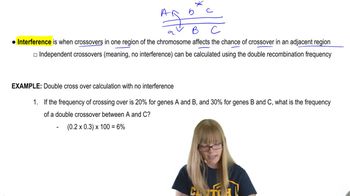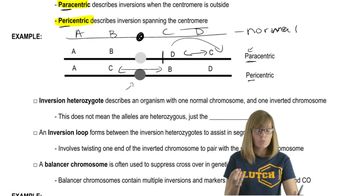Inversions are said to 'suppress crossing over.' Is this terminology technically correct? If not, restate the description accurately.
Table of contents
- 1. Introduction to Genetics51m
- 2. Mendel's Laws of Inheritance3h 37m
- 3. Extensions to Mendelian Inheritance2h 41m
- 4. Genetic Mapping and Linkage2h 28m
- 5. Genetics of Bacteria and Viruses1h 21m
- 6. Chromosomal Variation1h 48m
- 7. DNA and Chromosome Structure56m
- 8. DNA Replication1h 10m
- 9. Mitosis and Meiosis1h 34m
- 10. Transcription1h 0m
- 11. Translation58m
- 12. Gene Regulation in Prokaryotes1h 19m
- 13. Gene Regulation in Eukaryotes44m
- 14. Genetic Control of Development44m
- 15. Genomes and Genomics1h 50m
- 16. Transposable Elements47m
- 17. Mutation, Repair, and Recombination1h 6m
- 18. Molecular Genetic Tools19m
- 19. Cancer Genetics29m
- 20. Quantitative Genetics1h 26m
- 21. Population Genetics50m
- 22. Evolutionary Genetics29m
6. Chromosomal Variation
Chromosomal Rearrangements: Inversions
Problem 21
Textbook Question
The outcome of a single crossover between nonsister chromatids in the inversion loop of an inversion heterozygote varies depending on whether the inversion is of the paracentric or pericentric type. What differences are expected?
 Verified step by step guidance
Verified step by step guidance1
Understand the key terms: A paracentric inversion occurs when the inversion does not include the centromere, while a pericentric inversion includes the centromere. Both types involve a segment of a chromosome being flipped 180 degrees, but their outcomes differ during meiosis due to the involvement of the centromere.
In a paracentric inversion, during meiosis, a single crossover within the inversion loop results in the formation of a dicentric chromatid (with two centromeres) and an acentric fragment (lacking a centromere). The dicentric chromatid often breaks during anaphase I, and the acentric fragment is lost because it cannot attach to the spindle apparatus.
In a pericentric inversion, a single crossover within the inversion loop results in chromatids with duplications and deletions of genetic material. This happens because the centromere is included in the inversion, and the crossover disrupts the normal alignment of homologous regions.
Compare the outcomes: In paracentric inversions, the primary issue is the mechanical instability caused by the dicentric and acentric chromatids, leading to chromosome breakage and loss. In pericentric inversions, the main problem is the production of unbalanced gametes due to duplications and deletions of genetic material.
Summarize the differences: Paracentric inversions lead to structural instability (dicentric and acentric chromatids), while pericentric inversions result in genetic imbalances (duplications and deletions). Both types of inversions reduce fertility due to the production of nonviable gametes.
 Verified video answer for a similar problem:
Verified video answer for a similar problem:This video solution was recommended by our tutors as helpful for the problem above
Video duration:
51sPlay a video:
Was this helpful?
Key Concepts
Here are the essential concepts you must grasp in order to answer the question correctly.
Crossover Events
Crossover events occur during meiosis when homologous chromosomes exchange genetic material. This process is crucial for genetic diversity, as it can result in new combinations of alleles. The outcome of a crossover can vary significantly based on the chromosomal structure and the specific regions involved, particularly in the context of inversions.
Recommended video:
Guided course

Multiple Cross Overs and Interference
Inversion Types
Inversions are chromosomal rearrangements where a segment of a chromosome is reversed end to end. There are two main types: paracentric inversions, which do not include the centromere, and pericentric inversions, which do. The type of inversion affects the outcome of crossover events, particularly in how they can lead to viable or nonviable gametes.
Recommended video:
Guided course

Inversions
Genetic Consequences of Inversions
The genetic consequences of inversions can lead to various outcomes during meiosis, including the production of gametes with duplications or deletions of genetic material. In paracentric inversions, crossover can result in acentric fragments that are lost, while pericentric inversions can produce gametes with altered gene dosage. Understanding these consequences is essential for predicting the viability of offspring.
Recommended video:
Guided course

Inversions
Related Videos
Related Practice
Textbook Question
565
views


